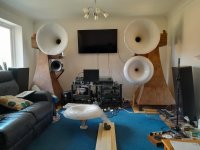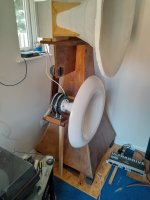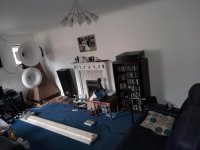Very good inspiration article, but I favour using pro (midbass) drivers rather than sub drivers, for multiple reasons.
The 12 Shivas has a very low -6dB frequency (about 10Hz). I doubt the music that I listen to is optimised for / has any response below 20Hz 🙂
I am happy to trade an octave or so of LF for better top end & higher efficiency.
The 12 Shivas has a very low -6dB frequency (about 10Hz). I doubt the music that I listen to is optimised for / has any response below 20Hz 🙂
I am happy to trade an octave or so of LF for better top end & higher efficiency.
- More efficiency means I don't need bigger amps for the LF.
- More efficiency means longer battery life (off grid build),
I can confirm that midbass can need some filling in. Previously I built a midbass horn with the JBL 2220H in a horn with 15cm throat, 70 cm depth and 70 cm diameter mouth. It came out a bit small and sounded a bit thin for a midbass channel. SPL varied a lot where I stood in the room. So I added a ported JBL 2225H in a 75L box, and the combination of these two was really the best solution. An even better solution would be to build a larger midbass horn. But I suspect it would need some help as well.
"SPL varied a lot where I stood in the room"
Pretty sure that's due to boundary interactions (room modes) rather than from the horn being slightly truncated.
In a standard stereo system, a few dB of ripple (from an undersize horn) will usually swamped by the >10dB peaks and nulls that room modes cause.
Mr BA's plot (post 172) shows a pretty large bass suckout, and my project (linked in post 178) does not - but most of this difference is because my project was built + used outside, therefore room modes are not a thing.
LF systems (horn or othersise) that are indoors & heavily influenced by room modes will usually be improved by adding more sources (e.g. an additional bass box or two) because those sources will trigger different room modes / fill in some of the nulls of the main system.
Pretty sure that's due to boundary interactions (room modes) rather than from the horn being slightly truncated.
In a standard stereo system, a few dB of ripple (from an undersize horn) will usually swamped by the >10dB peaks and nulls that room modes cause.
Mr BA's plot (post 172) shows a pretty large bass suckout, and my project (linked in post 178) does not - but most of this difference is because my project was built + used outside, therefore room modes are not a thing.
LF systems (horn or othersise) that are indoors & heavily influenced by room modes will usually be improved by adding more sources (e.g. an additional bass box or two) because those sources will trigger different room modes / fill in some of the nulls of the main system.
Finally managed to get some free time, to do a bit of woodworking & install one Celstion unit
[second fibre glass horn needs some repair work before I use it].

Due to analog inputs not working on Apogee Rosetta, I've put Behringer DCX2496 back into service.
RH, all on LR24
[?]-250Hz via Fane Crescendo 15"
250Hz-1kHz via Audax PR170
1kHz-20kHz via Celestion axi2050
LH
[?]-250Hz via Fane Crescendo 15"
250Hz-1kHz via Audax PR170
1kHz-8kHz via Fostex D232
We're looking after a nervous dog, so no measuring yet, but sounds ok so far.

[second fibre glass horn needs some repair work before I use it].

Due to analog inputs not working on Apogee Rosetta, I've put Behringer DCX2496 back into service.
RH, all on LR24
[?]-250Hz via Fane Crescendo 15"
250Hz-1kHz via Audax PR170
1kHz-20kHz via Celestion axi2050
LH
[?]-250Hz via Fane Crescendo 15"
250Hz-1kHz via Audax PR170
1kHz-8kHz via Fostex D232
8kHz JBL 2405 [using a capacitor, due to only 3 stereo outputs on Behringer].
We're looking after a nervous dog, so no measuring yet, but sounds ok so far.

Finally managed to do an initial measure to set relative driver levels. Microphone is approx in the listening position, which is approx 4m (13 feet) from horn mouth and centred between both horns. All with 1/6 smoothing.

RH 3 way measure (Fane 15" phase inverted - green / blue)

LH 4 way measure - this caused me to look at the phase of Fane & invert it.

Then we have a comparison of 3way v 4 way.

All comments welcome.

RH 3 way measure (Fane 15" phase inverted - green / blue)
LH 4 way measure - this caused me to look at the phase of Fane & invert it.
Then we have a comparison of 3way v 4 way.
All comments welcome.
The peak at between 1500 and 2500Hz, can you cleck what happens to it without a super tweeter? Just use the midrange as high as you can go? And maybe also, use only one midrange horn?
Yes, at least 1 and 2, because supertweeters can interact with the midrange in a negative way.
And measure at different locations as room modes can play some tricks on you. Dirac Live asked me to do eight measurements around listening position. Also, if you sit with a cocrete wall behind the sofa this will can add some boomy peaks in the bass.
And measure at different locations as room modes can play some tricks on you. Dirac Live asked me to do eight measurements around listening position. Also, if you sit with a cocrete wall behind the sofa this will can add some boomy peaks in the bass.
Here's a few more measurements from practically the same spot as yesterdays.
LH = 4 way; RH = 3 way all drivers playing.

LH 4 way speaker - Green trace all drivers, blue trace is addax, fostex & jbl playing.

Then we mute Fane & Audax, leaving Fostex & jbl playing.

Then mute Fane 15" & JBL 2405, leaving Audax & Fostex playing.

LH = 4 way; RH = 3 way all drivers playing.
LH 4 way speaker - Green trace all drivers, blue trace is addax, fostex & jbl playing.
Then we mute Fane & Audax, leaving Fostex & jbl playing.
Then mute Fane 15" & JBL 2405, leaving Audax & Fostex playing.
Last edited:
The peak at 800Hz doesn’t seem to want to go away. Something inherent with the Audax driver?
Can you be very clear with each graph which driver is playing? A bit confusing right now.
Can you be very clear with each graph which driver is playing? A bit confusing right now.
800 hz peak I agree. I need to look at old measurements. Post 191 updated to hopefully be clearerThe peak at 800Hz doesn’t seem to want to go away. Something inherent with the Audae.
Last edited:
I think it's fair to say that Celestion axi2050 needs help in my application at higher frequencies. I may even struggle getting it to meet jbl 2405 @ 7 / 8kHz
If you want a quick and fee and fairly easy way to do a fair comparison of the 3-way with the 4-way, use a laptop as your music source. Download Equalizer APO and create a couple of EQ presets, so that you can flip between the two setups, with both equalised to the same (flat) response.I think it's fair to say that Celestion axi2050 needs help in my application at higher frequencies. I may even struggle getting it to meet jbl 2405 @ 7 / 8kHz
To my eye, a 6dB / octave boost starting at 3 or 4kHz would be about right, so you could potentially use a passive line level crossover (give the celestion its own amp) as a long term solution, if you want a "simple" all analogue rig.
The peak at 800Hz doesn’t seem to want to go away. Something inherent with the Audax driver?
I tried lots of drivers including something very similar - I found a Chinese driver that is an obvious clone of the Audax, and liked it so much I bought ten.
I didn't find any inherent issues with putting them on a horn. I eventually went with a more modern 5" driver not because it is any flatter, but because it has a wider bandwidth on the same horn (allowing a 2kHz cross to the tweeter).
Sometimes, free "hacks" can fix or minimise horn+driver problems (measure before and after),
- Intentionally introduce some asymmetry, e.g. mount the driver slightly off centre, or stick a bit of foam in one side of the fhroat.
- try different mounting methods / gaskets.
The attached image is an example, it shows a 4" driver (NE123W-08) on a 2" throat horn
from this thread: https://www.diyaudio.com/community/threads/paper-cone-open-frame-driver-for-front-horn.275899/page-2
The bad plot is the NE123 mounted with a normal (airtight) gasket. The good plot is a leaky gasket (a ring cut out of a double walled cardboard box - so air can leak through the corrugations).
The leaky gasket has nearly an extra octave of flat response. That is an unusually good (lucky) improvement. Most tweaks (or driver swaps) give relatively small changes.
Attachments
Thanks for your help, first, I'll see if I can find a similar function within Behringer DCX2496If you want a quick and fee and fairly easy way to do a fair comparison of the 3-way with the 4-way, use a laptop as your music source. Download Equalizer APO and create a couple of EQ presets, so that you can flip between the two setups, with both equalised to the same (flat) response.
- Home
- Loudspeakers
- Multi-Way
- A 4-way Horn speaker
